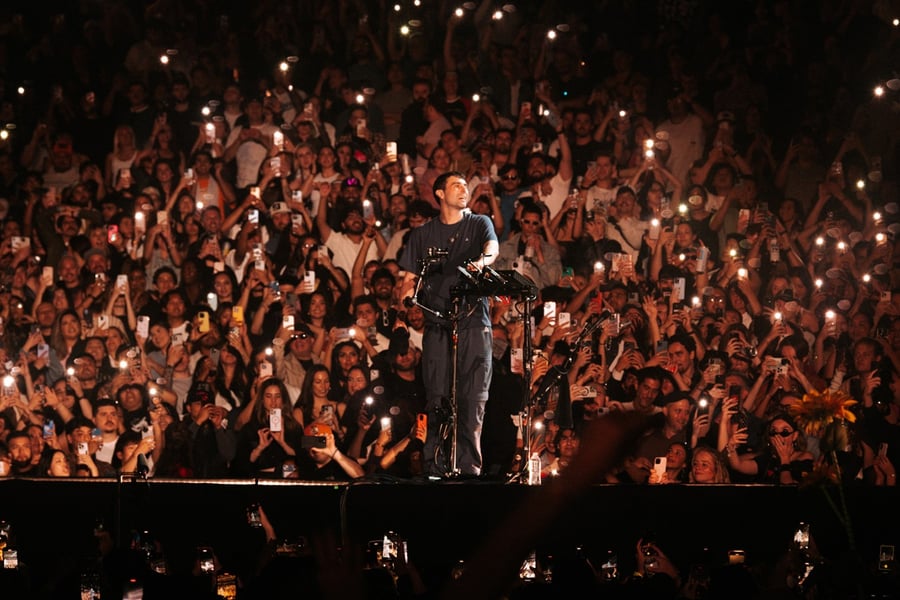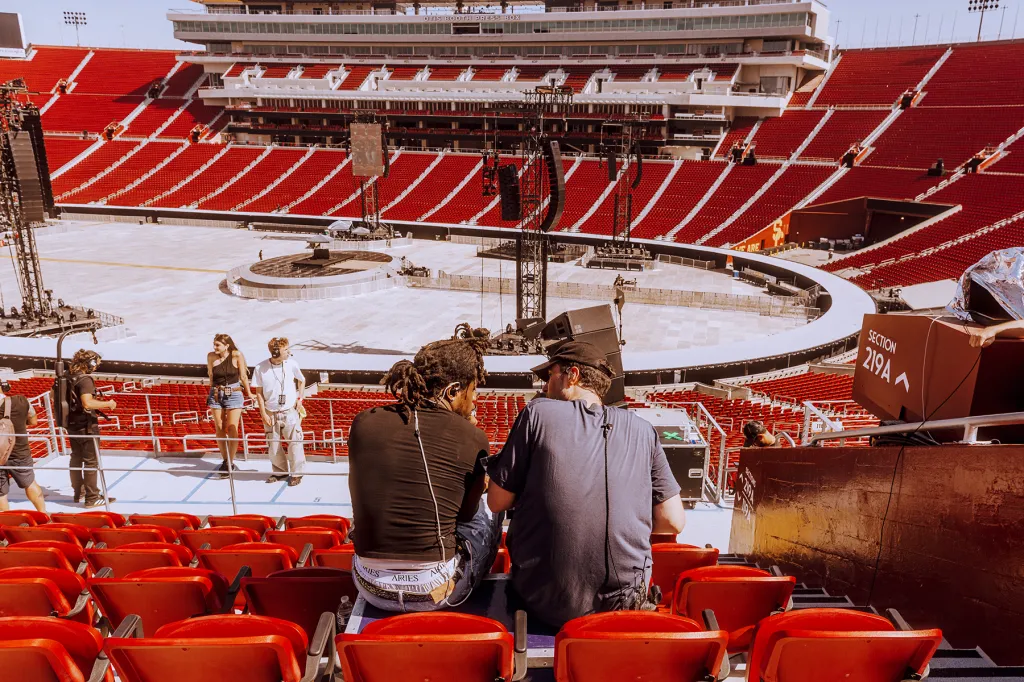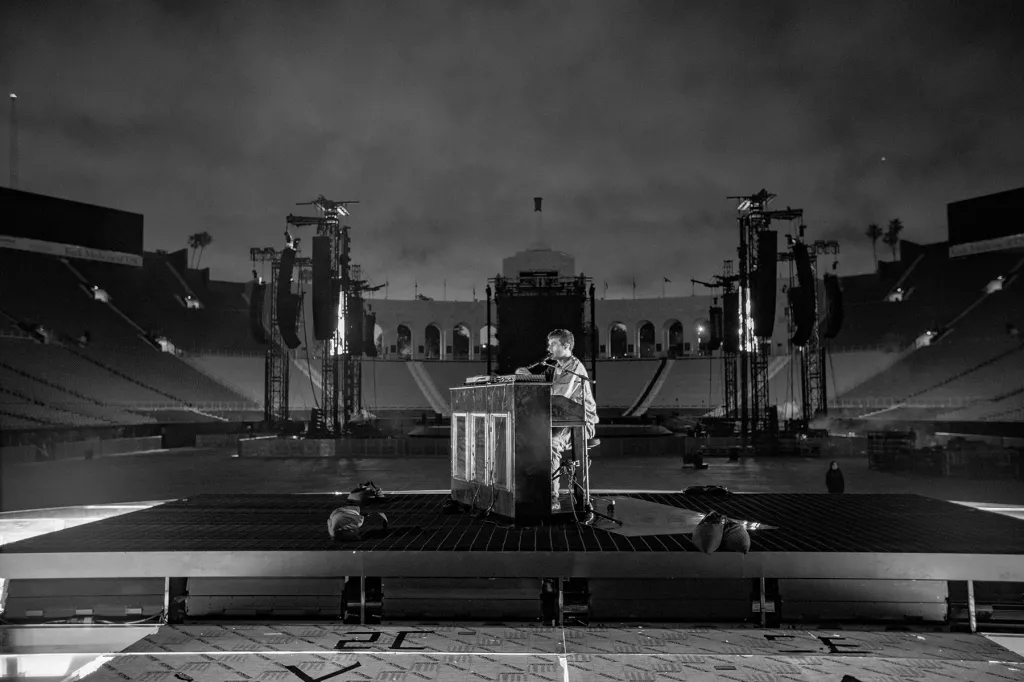The British musician Fred again.. is best known for creating intimate listening experiences at scale. He gained critical and fan acclaim for his 2021 project Actual Life, where he composed original tracks using an array of sonic fragments, ranging from voice memos and snippets from social media to bits and pieces of sounds from other artists. He described the project at the time as something of a diary of the beginning of the pandemic, a period when the whole world was seeking connection in digital space. Since then, he’s dropped two sequels to Actual Life and brought his expansive style of electronic music to massive IRL crowds around the world. You’ve likely seen fan-recorded clips scattered across social media. Entry points include: Fred again.. alongside Skrillex performing in Times Square; Fred again.., Four Tet, and Skrillex at a sold-out Madison Square Garden; or Fred’s Boiler Room set, one of the site’s most viewed of all time.
The latest addition to the canon is Fred’s first-ever stadium show at the Los Angeles Memorial Coliseum, which took place last month. The event drew a nearly sold-out crowd to the 77,500-capacity venue and was Fred’s largest show to date. The elaborate setup included more than six stages where Fred, alongside musicians Romy and Obongjayar, performed in various formations. In one viral clip from the show, Fred and Obongjayar, the Nigerian-British singer-songwriter who collaborated with Fred on the single “Adore You,” perform from the stands, flanked by frenzied fans.
The idea for a show at the historic stadium where the likes of Pink Floyd and Metallica have headlined was first planted during Fred’s residency at the nearby Shrine Auditorium last year. “When we were playing those shows, someone from my team was like, ‘Let’s go check out this venue,’” Fred recalls. “I thought it could be a really interesting creative challenge to try and do something big. They were like, ‘This is a big venue, but it looks like it’s one that you could make the sound good at.’”
“The first secret was to find a stadium without a roof!” explains Jamie Tinsley, who runs sound for all of Fred’s live shows. “Roofs are nearly always put over the audience area, mainly for weather protection and the ability to add lighting and other technology. However, they’re also acoustically designed to reflect the audience’s cheers back down onto the pitch to create a louder live atmosphere. This is our number one nightmare when trying to manage sound reflections in large music venues.”
The L.A. Coliseum’s unobstructed, open-air design made for the perfect large-scale venue for what Fred and his team had in mind. “As soon as we got there, it’s so powerfully understated — just red seats. There’s almost no adverts or anything. All you could see was just red seats,” Fred says. “The fact that it’s this slow incline as opposed to the seats being sharp and high means that most of the [sound] reflections are going out as opposed to bouncing back in.”
“Fred mentioned he wanted nightclub sound everywhere,” Tinsley explains. “In my eyes, the only way to achieve this is to bring the speakers closer to the people. I wanted to design a setup where everyone was within 60 meters of a speaker at any given place. The tricky part here is that the bleacher depth around the stadium is 100 meters alone!”
The solution was to add 21 cardioid speaker stacks halfway up, which Tinsley says would prevent an undesired fluttering sound effect. This was coupled with a doughnut shape of 68 triple 21-inch cardioid subs around the stage for even coverage throughout the venue, backed up by additional subs for the points furthest away. “The consensus was like, if we go mental enough on the PA, it could be possible to make this sound genuinely good,” Fred says. “And then I got really excited at the premise of like, ‘Oh, my God, we can make the best sounding thing ever.’”
Love Music?
Get your daily dose of everything happening in Australian/New Zealand music and globally.
But sound wasn’t the only concern. Fred’s ethos throughout his ascent these past few years has been a genuine connection with fans, whether via the smaller, more intimate shows he enjoys playing at Corsica Studios in London or in the elaborate arena shows that have grown monumentally popular in a short time. “I think the challenge to me at the Coliseum was I really wanted to find ways that I could connect as much as possible to people in this vast space,” Fred explains. “Which is why we did that thing — Lucy and I call it the moat — we built this thing all the way around that I could walk along. That meant I could walk to the different stages.”
Lucy Hickling, Fred’s creative director, didn’t want to lose the essence of the shows they’ve done thus far, which have cultivated a sense of intimacy that audiences have come to appreciate in post-pandemic nightlife. ”I think the thing that makes a Fred show, and always has made it so special, is that closeness that everyone has and everyone feels like they’re all in it together. I think it’s been such a quick journey that it would be such a shame to lose that feeling, especially so early on in the relativity of his entire career to come,” she says. “We worked with Human Person, who are a design team, who are amazing and so great and took on every idea that we had so well and made it even better each time.”
.@fredagainagain1 and @obongjayar joining the audience at the Memorial Coliseum to perform "adore u" is too wholesome 🥹🫶
h/t: @AllTimeEDM pic.twitter.com/6x8rDTHWZP
— EDM.com (@TheEDMNetwork) June 17, 2024
A major part of the stage design was the so-called moat, which encircled the field inside the venue and allowed each artist to engage with the entire crowd. “Being able to ensure production was surrounding everyone, and everyone was able to feel part of the show as opposed to just watching the show, was important,” Hickling explains. “It’s all about being in the same room as the artist, and I think that people really crave that. People really crave being in the same room as an artist because we spend so much time staring at them on our phones or, especially during lockdown, which is when Fred’s thing started, you just didn’t get to experience anything.
“And then we built another stage as well, which mirrored the same design, and that’s where the more complex songs were played, and then obviously Fred did the MPC where he battled Tony and they used two opposite sides of the moat,” Hickling continues. “There were six spots that Fred performed in throughout as well as walking around the entire circumference of the stadium.”
It was an intimate experience for the performers, too. “I think the way that we set up the performance of ‘Strong,’ Fred and I kind of start the performance singing, facing each other and with the eye contact and the intimacy between us,” Romy says of performing her collaboration with Fred. “That kind of created this kind of intimate world where it felt like it was just Fred and I there, especially when you’re listening with the in-ears. So it felt quite like a surreal dream to be in the middle of this 360-degree world of people around us.”
The singer-songwriter, who is also one half of the electronic duo the xx, admits they were initially nervous, “but there was that kind of safety that I feel between, the confidence that Fred gives me, I feel like we’ve got this together,” she says. “Then when [the beat] finally dropped and I was just dancing around, just really taking it in and just looking around and trying to connect with people and seeing different people’s reactions, it was really special and something very unique to be able to perform that song in the round like that. A very, very dreamlike scenario, to be honest.”
When it came down to actually putting together a set list, Fred says there was no real methodology; instead, he was focused on making sure he could move around the various stages. “It was more just like I wanted to work out a set list that hopefully wasn’t too stop-start that allowed me to move around,” he says. “How could we play in five different locations and try and keep the momentum in the right place?”
The closest comparison might be the raves you typically find in the club world, full of booming, dynamic sound and a sense of closeness to the DJ. “I would never want to say that we’re copying club culture because it would be unfair to make that comparison,” Hickling says. “However, I think there’s a lot of Fred fans who don’t know much about dance music, and being able to introduce small elements of dance music to people who might necessarily never have been to a club or to a deep rave is a nice thing to be able to do. Musically, the show offers so many different styles of music that it’s not any kind of show. It’s just a unique musical experience. I don’t think you can put it in a box.”
Jenn Yacoubian, executive vice president of Goldenvoice, who has worked with Fred for several years, says it was unlike any other event she’s seen in her career as a promoter. “I think they were so intentional about sound right from the first walk-through. We did follow-up walk-throughs and brought in different sound engineers and experts like, ‘OK, how can we make it sound and have that experience of sounding as incredible as it would have in a thousand-cap room?’” she explains. “It was unlike any kind of other large-scale show I’ve seen where even that far up you felt just right in the middle of it because of the sound.”
With this latest feat now behind them, Fred and his team are taking a well-earned breather, but the wheels are already turning on what kinds of challenges they might want to tackle next. “We did this show two days before the Coliseum for like 150 people in the stands of the Coliseum; I just played very stripped-down music for the OG people who were at the first shows and stuff like that,” Fred says. “We all found that show really eye-opening. That was a really beautiful energy. So I’m thinking about working out a way of doing more of that vibe as well.”
From Rolling Stone US






































